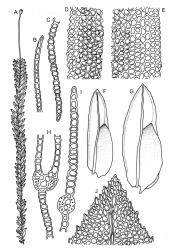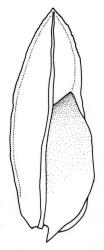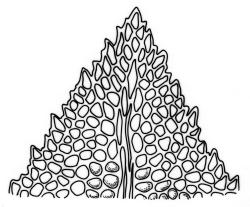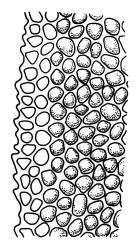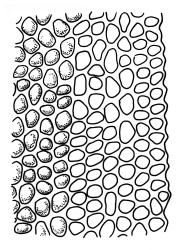Plants 20–90 mm, yellow-green to dark green, brown below, densely gregarious. Stems occasionally branched, with rhizoids copious in leaf axils. Leaves in 10–50 pairs, overlapping at mid stem, patent, slightly decurved when moist, with apices crispate and inrolled when dry, oblong-lanceolate, 2.0–3.5 × 0.5–1.2 mm; apex acute; laminae unistratose; vaginant laminae ½–⅔ leaf length, partially closed; dorsal lamina usually ending at leaf insertion, often rounded there; margins serrate on dorsal, apical and vaginant laminae, irregularly and coarsely serrate towards the leaf apex; marginal cells on all laminae distinct in several rows, flatter and thicker-walled, forming a pale, unistratose band; cells of apical and dorsal laminae quadrate to hexagonal, ± isodiametric, smooth, moderately bulging, with moderately thick walls, (9–)12–20(–24) × (9–)12–20(–24) µm. Costa failing 2–4 cells below leaf apex, taxifolius-type in cross-section.
Dioicous. Perichaetia single in axils of leaves at mid stem; perichaetial leaves greatly reduced. Perigonia in clusters in axils of leaves at mid stem. Setae orange-brown, thin, sinuose, 15–20 mm; capsules erect to horizontal, asymmetric, 1.0–1.6 mm; exothecial cells in c. 100 columns; operculum obliquely rostrate from a conic base, ¾ to equal the length of theca. Peristome taxifolius-type; teeth 80–130 µm wide at base. Calyptra smooth, cucullate. Mature spores not seen.
Crum & Anderson 1981, fig. 36, A–E; Beever et al. 2002, p. 12, figs 1–6; Smith 2004, fig. 77, 7–10; Stone & Catcheside 2012.
NI: N Auckland ("Auckland", Puhinui Creek), S Auckland (Waikato), Gisborne (Waikaremoana), Wellington; SI: Nelson, Canterbury, Westland, Otago, Southland; Ch.
Bipolar. Tasmania* and mainland Australia*. Reported from Chile (He 1998) and Argentina (Matteri & Schiavone 2004). Widespread in the northern hemisphere.
A large, aquatic species, emergent or submerged, found mostly in wet depressions and at lake margins. However, F. adianthoides also occurs as a deep-water bryophyte in several N.Z. lakes (de Winton & Beever 2004). Associated mosses include Leptodictyum riparium, Bryum laevigatum, Campyliadelphus stellatus, Distichophyllum kraussei, D. pulchellum var. pulchellum, Hypnodendron marginatum, and Thamnobryum pandum.
The species appears to be more common in the South I. than in the North I. Elevation records extend from c. 10 m (Waikato Basin, S Auckland L.D.) to 1645 m (St Arnaud Range, Nelson L.D.).
Collections are almost all from indigenous vegetation, and this is a dioicous species with both sexes occurring in N.Z. These two factors suggest that it is indigenous here.
Deep-water forms have more distant leaves, which may be a response to low light intensities, but the size of the laminal cells is unaltered.




